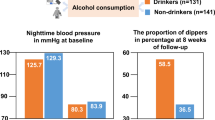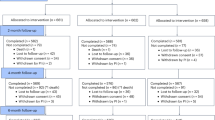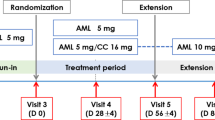Abstract
Cilnidipine is a novel and unique 1,4-dydropyridine derivative calcium antagonist that exerts potent inhibitory actions not only on L-type but also on N-type voltage-dependent calcium channels. Blockade of the neural N-type calcium channel inhibits the secretion of norepinephrine from peripheral neural terminals and depresses sympathetic nervous system activity. The purpose of this study was to assess the effect of cilnidipine and amlodipine on ambulatory blood pressure (BP) levels. We performed 24-h ambulatory BP monitoring before and after once-daily use of cilnidipine (n=55) and amlodipine (n=55) in 110 hypertensive patients. Both drugs significantly reduced clinic and 24-h systolic BP (SBP) and diastolic BP (DBP) (p<0.005). However, the reductions of 24-h (−1.19±6.78 vs. 1.55±6.13 bpm, p=0.03), daytime (−1.58±6.72 vs. 1.68±7.34 bpm, p=0.02) and nighttime (−1.19±5.72 vs. 1.89±6.56 bpm, p=0.01) pulse rate (PR) were significantly greater in the cilnidipine group than the amlodipine group. There was no correlation between the degree of daytime SBP change and that of daytime PR change after amlodipine treatment (r=−0.08, n.s.), but there was a significant negative correlation between the degree of daytime SBP change and that of daytime PR change after cilnidipine treatment (r=−0.27, p<0.05). N-type calcium channel blockade by cilnidipine may not cause reflex tachycardia, and may be useful for hypertensive treatment.
Similar content being viewed by others
Article PDF
References
Fukuo K, Yang J, Suzuki T, et al: Nifedipine upregulates manganese superoxide dismutase expression in vascular smooth muscle cells via endothelial cell-dependent pathways. Hypertens Res 2003; 26: 503–508.
Yao K, Sato H, Sonoda R, Ina Y, Suzuki K, Ohno T : Effects of benidipine and candesartan on kidney and vascular function in hypertensive Dahl rats. Hypertens Res 2003; 26: 569–576.
Umemoto S, Tanaka M, Kawahara S, et al: Calcium antagonist reduces oxidative stress by upregulating Cu/Zn superoxide dismutase in stroke-prone spontaneously hypertensive rats. Hypertens Res 2004; 27: 877–885.
Yamagata K, Ichinose S, Tagami M : Amlodipine and carvedilol prevent cytotoxicity in cortical neurons isolated from stroke-prone spontaneously hypertensive rats. Hypertens Res 2004; 27: 271–282.
Yui Y, Sumiyoshi T, Kodama K, et al: Comparison of nifedipine retard with angiotensin converting enzyme inhibitors in Japanese hypertensive patients with coronary artery disease: the Japan Multicenter Investigation for Cardiovascular Diseases-B (JMIC-B) randomized trial. Hypertens Res 2004; 27: 181–191.
Yui Y, Sumiyoshi T, Kodama K, et al: Nifedipine retard was as effective as angiotensin converting enzyme inhibitors in preventing cardiac events in high-risk hypertensive patients with diabetes and coronary artery disease: the Japan Multicenter Investigation for Cardiovascular Diseases-B (JMIC-B) subgroup analysis. Hypertens Res 2004; 27: 449–456.
Saruta T : Current status of calcium antagonists in Japan. Am J Cardiol 1998; 82: 32R–34R.
Hirose H, Saito I : Trends in blood pressure control in hypertensive patients with diabetes mellitus in Japan. Hypertens Res 2003; 26: 717–722.
Grossman E, Messerli FH : Effect of calcium antagonists on sympathetic activity. Eur Heart J 1998; 19 ( Suppl F): F27–F31.
Kario K, Shimada K : Differential effects of amlodipine on ambulatory blood pressure in elderly hypertensive patients with different nocturnal reductions in blood pressure. Am J Hypertens 1997; 10: 261–268.
Kuramoto K, Ichikawa S, Hirai A, Kanada S, Nakachi T, Ogihara T : Azelnidipine and amlodipine: a comparison of their pharmacokinetics and effects on ambulatory blood pressure. Hypertens Res 2003; 26: 201–208.
Fujii S, Kameyama K, Hosono M, Hayashi Y, Kitamura K : Effect of cilnidipine, a novel dihydropyridine Ca++-channel antagonist, on N-type Ca++ channel in rat dorsal root ganglion neurons. J Pharmacol Exp Ther 1997; 280: 1184–1191.
Hirning LD, Fox AP, McCleskey EW, et al: Dominant role of N-type Ca2+ channels in evoked release of norepinephrine from sympathetic neurons. Science 1988; 239: 57–61.
Minami J, Ishimitsu T, Kawano Y, Numabe A, Matsuoka H : Comparison of 24-hour blood pressure, heart rate, and autonomic nerve activity in hypertensive patients treated with cilnidipine or nifedipine retard. J Cardiovasc Pharmacol 1998; 32: 331–336.
Minami J, Ishimitsu T, Higashi T, Numabe A, Matsuoka H : Comparison between cilnidipine and nisoldipine with respect to effects on blood pressure and heart rate in hypertensive patients. Hypertens Res 1998; 21: 215–219.
Kario K, Pickering TG, Umeda Y, et al: Morning surge in blood pressure as a predictor of silent and clinical cerebrovascular disease in elderly hypertensives: a prospective study. Circulation 2003; 107: 1401–1406.
Panza JA, Epstein SE, Quyyumi AA : Circadian variation in vascular tone and its relation to alpha-sympathetic vasoconstrictor activity. N Engl J Med 1991; 325: 986–990.
Sakata K, Shirotani M, Yoshida H, et al: Effects of amlodipine and cilnidipine on cardiac sympathetic nervous system and neurohormonal status in essential hypertension. Hypertension 1999; 33: 1447–1452.
Tomiyama H, Kimura Y, Kuwabara Y, et al: Cilnidipine more highly attenuates cold pressor stress-induced platelet activation in hypertension than does amlodipine. Hypertens Res 2001; 24: 679–684.
Gillman MW, Kannel WB, Belanger A, D'Agostino RB : Influence of heart rate on mortality among persons with hypertension: the Framingham Study. Am Heart J 1993; 125: 1148–1154.
Furberg CD, Psaty BM, Meyer JV : Nifedipine: dose-related increase in mortality in patients with coronary heart disease. Circulation 1995; 92: 1326–1331.
Psaty BM, Heckbert SR, Koepsell TD, et al: The risk of myocardial infarction associated with antihypertensive drug therapies. JAMA 1995; 274: 620–625.
Ruzicka M, Leenen FH : Relevance of 24 h blood pressure profile and sympathetic activity for outcome on short-versus long-acting 1,4-dihydropyridines. Am J Hypertens 1996; 9: 86–94.
Chobanian AV, Bakris GL, Black HR, et al: The seventh report of the Joint National Committee on Prevention, Detection, Evaluation, and Treatment of High Blood Pressure: the JNC 7 report. JAMA 2003; 289: 2560–2571.
Faulkner JK, McGibney D, Chasseaud LF, Perry JL, Taylor IW : The pharmacokinetics of amlodipine in healthy volunteers after single intravenous and oral doses and after 14 repeated oral doses given once daily. Br J Clin Pharmacol 1986; 22: 21–25.
Minami J, Ishimitsu T, Kawano Y, Matsuoka H : Effects of amlodipine and nifedipine retard on autonomic nerve activity in hypertensive patients. Clin Exp Pharmacol Physiol 1998; 25: 572–576.
Lefrandt JD, Heitmann J, Sevre K, et al: The effects of dihydropyridine and phenylalkylamine calcium antagonist classes on autonomic function in hypertension: the VAMPHYRE study. Am J Hypertens 2001; 14: 1083–1089.
Struck J, Muck P, Trubger D, et al: Effects of selective angiotensin II receptor blockade on sympathetic nerve activity in primary hypertensive subjects. J Hypertens 2002; 20: 1143–1149.
ALLHAT Officers and Coordinators for the ALLHAT Collaborative Research Group : Major outcomes in high-risk hypertensive patients randomized to angiotensin-converting enzyme inhibitor or calcium channel blocker vs diuretic: the Antihypertensive and Lipid-Lowering Treatment to Prevent Heart Attack Trial (ALLHAT). JAMA 2002; 288: 2981–2997.
Ishii M, Kakuo M, Shishido R, Okuno T, Itida S, Matsumoto M : Phase 1 clinical study of FRC-8635 (cilnidipine): single-dose study. Jpn Pharmacol Ther 1993; 21 ( Suppl 1): S7–S22.
Morimoto S, Takeda K, Oguni A, et al: Reduction of white coat effect by cilnidipine in essential hypertension. Am J Hypertens 2001; 14: 1053–1057.
Kojima S, Shida M, Yokoyama H : Comparison between cilnidipine and amlodipine besilate with respect to proteinuria in hypertensive patients with renal diseases. Hypertens Res 2004; 27: 379–385.
Ikeda T, Gomi T, Shibuya Y, et al: Morning rise in blood pressure is a predictor of left ventricular hypertrophy in treated hypertensive patients. Hypertens Res 2004; 27: 939–946.
Kuroda T, Kario K, Hoshide S, et al: Effects of bedtime vs. morning administration of the long-acting lipophilic angiotensin-converting enzyme inhibitor trandolapril on morning blood pressure in hypertensive patients. Hypertens Res 2004; 27: 15–20.
Tachibana R, Tabara Y, Kondo I, Miki T, Kohara K : Home blood pressure is a better predictor of carotid atherosclerosis than office blood pressure in community-dwelling subjects. Hypertens Res 2004; 27: 633–639.
Uchida H, Nakamura Y, Kaihara M, et al: Practical efficacy of telmisartan for decreasing morning home blood pressure and pulse wave velocity in patients with mild-to-moderate hypertension. Hypertens Res 2004; 27: 545–550.
Dodt C, Breckling U, Derad I, Fehm HL, Born J : Plasma epinephrine and norepinephrine concentrations of healthy humans associated with nighttime sleep and morning arousal. Hypertension 1997; 30: 71–76.
Waeber B, Brunner HR : Clinical value of ambulatory blood pressure monitoring in the assessment of antihypertensive therapy. Blood Press Monit 1999; 4: 263–266.
Andrejak MJ : Aims of ambulatory blood pressure monitoring during phase II and III clinical trials. Blood Press Monit 1996; 1: 309–311.
Author information
Authors and Affiliations
Corresponding author
Rights and permissions
About this article
Cite this article
Hoshide, S., Kario, K., Ishikawa, J. et al. Comparison of the Effects of Cilnidipine and Amlodipine on Ambulatory Blood Pressure. Hypertens Res 28, 1003–1008 (2005). https://doi.org/10.1291/hypres.28.1003
Received:
Accepted:
Issue date:
DOI: https://doi.org/10.1291/hypres.28.1003
Keywords
This article is cited by
-
L/N-type calcium channel blocker cilnidipine reduces plasma aldosterone, albuminuria, and urinary liver-type fatty acid binding protein in patients with chronic kidney disease
Heart and Vessels (2013)
-
L/N-type calcium channel blocker suppresses reflex aldosterone production induced by antihypertensive action
Heart and Vessels (2012)
-
The N-type and L-type calcium channel blocker cilnidipine suppresses renal injury in Dahl rats fed a high-salt diet
Heart and Vessels (2010)
-
Higher Heart Rate May Predispose to Obesity and Diabetes Mellitus: 20-Year Prospective Study in a General Population
American Journal of Hypertension (2009)
-
Antiproteinuric effect of the calcium channel blocker cilnidipine added to renin-angiotensin inhibition in hypertensive patients with chronic renal disease
Kidney International (2007)



